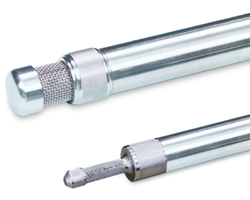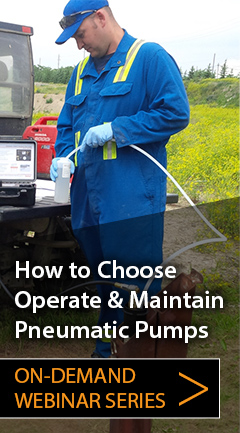Which is best for your application?
 Both Solinst Bladder Pumps and Double Valve Pumps provide representative groundwater samples, each with their own advantages.
Both Solinst Bladder Pumps and Double Valve Pumps provide representative groundwater samples, each with their own advantages.
Solinst Bladder Pumps are designed so that the sample water never comes into contact with drive gas or compressed air. This makes operation simple when setting a pump control unit’s drive and sample cycles, as you are assured of a non-contaminated sample.
In addition, the Solinst Electronic Pump Control Unit allows very slow compression of the bladder, which causes less disturbance to the sample water, minimizing off-gassing of the sample. Bladder Pumps also have low flow capabilities, and can provide flow rates of 100 ml/min or less. Because of these features, Bladder Pumps are ideal and approved by regulators worldwide for low flow, and VOC sampling.
Solinst Double Valve Pumps are operated in a similar manner as the Bladder Pump, but since they have no bladder, require more “fine-tuning” of drive and sample cycles to ensure that the drive gas does not enter the pump. If operated correctly, Double Valve Pumps provide low flow sampling and are capable of providing high quality, representative VOC samples.
Double Valve Pumps can provide higher flow rates, and because they have no bladder, they have better performance in silty water and are low maintenance because they have no bladder to replace and fewer parts to decontaminate.
Stainless steel pumps are ideal for most types of municipal, industrial and general environmental applications, especially where VOC analysis is important. The PVC pumps are more suitable for metals analysis and situations with highly corrosive liquids.
Generally, select a Bladder Pump for easier regulatory acceptance and lower flow rates; select a Double Valve Pump for faster purging, and operation in more turbid environments.
How is operation different?
When determining the amount of pressure required to lift a sample using a Bladder Pump, you must calculate using the depth of the Pump’s intake below ground surface (e.g. If the Bladder Pump’s intake is at 100 ft. below ground surface, you will require approximately 50 psi of pressure to bring a sample to ground surface. Note: 1 psi of pressure can raise a 2.3 ft. column of water).
If you are sampling with a Double Valve Pump, then this calculation is made from ground level to static water level, as a minimum, but can be made from total pump depth to maximize purging rates. As such, if a Double Valve Pump is 100 ft. below ground surface, and static water level is at 50 ft., you can select a pressure of between 25 and 50 psi. With both Bladder Pumps and Double Valve Pumps, add an extra 20 psi to allow for "line loss".
An advantage of the Bladder Pump is the ability to also be able to use it with no bladder. This allows you to continue sampling if you are in the field with no bladder replacements. Simply operate it like a Double Valve Pump.
For either Pump, samples can be obtained from greater depths using a drop tube assembly. This places the screened filter intake of the pump as deep as necessary to access the sample zone required. They are easily installed without tools on existing pumps, even in the field.
| Bladder Pump | Double Valve Pump | |
|---|---|---|
| Pump Material | Pump Diameter | |
| 316 Stainless Steel | 1" and 1.66" (25 mm and 42 mm) |
5/8" and 1.66" (16 mm and 42 mm) |
| PVC | 1.66" (42 mm) | 1.66" (42 mm) |
| PTFE (408 M only) | N/A | 3/8"(9.5 mm) |
| Pump Material | Maximum Depth | |
| 316 Stainless Steel | 500 ft (150 m) | 500 ft (150 m) |
| PVC | 100 ft (30 m) | 100 ft (30 m) |
| Pump Type | Minimum Flow Rate | |
| All | 100 ml/min or less | 100 ml/min or less |
| Pump Diameter | Maximum Flow Rate | |
| 3/8" (9.5 mm) (408 M) | N/A | 250 ml/min |
| 5/8" (16 mm) | N/A | 800 ml/min |
| 1" (25 mm) | 1000 ml/min | N/A |
| 1.66" (42 mm) | 1500 ml/min | 3500 ml/min |


